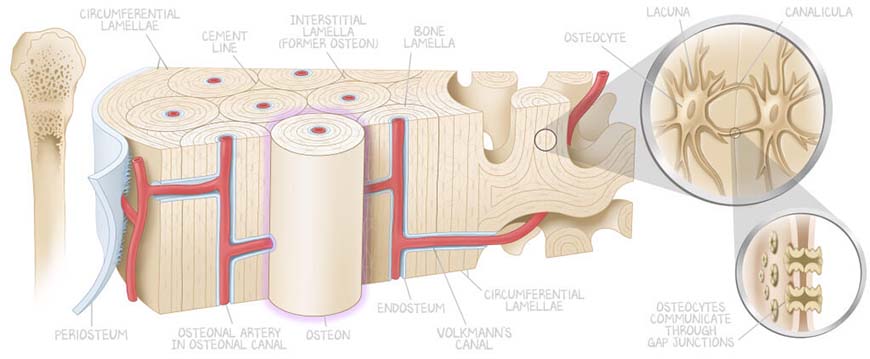It seems obvious that the purpose of medical illustrations is to facilitate understanding of anatomy and biological processes, but you wouldn’t know it from some illustrations out there.
Too often, they are flat, inaccurate, derivative, or depict way more than is needed to convey a single objective.
Illustrators end up referring to the same unfocused and inaccurate sources, resulting in a uniform set of illustrations that look the same – and make the same mistakes. More importantly, it leaves learners with a body of work that can hinder understanding.
Breaking the mold
There are both teams and individuals working to change the purpose and execution of illustrations. The team at OnlineMedEd—whose medical illustrations are consistently appealing in both their composition and clarity—is among this group of iconoclasts.
Goodrich’s knack for crafting Williams’ esoteric medical topics and feedback into visual approaches the illustrators can work with is a critical part of what makes OnlineMedEd’s illustrations great.
Their approach is simple; Dr Dustyn Williams, MD, the co-founder and lead educator, and Lisa Goodrich, the art director (and accomplished illustrator in her own right), work together with the artist at every point in the process.
Williams’ role is to be the catalyst that begins every individual illustration project and the fact-checker that keeps the illustrations accurate through rounds of revisions. He knows the story the illustration must tell, but not how.
Having the subject matter expert present throughout the illustration creation process is rare. Giving the illustrators the artistic freedom to figure out how to tell the story is even rarer. Williams cares about the ‘what’ and regularly meets with illustrators to review their work, but leaves the ‘how’ entirely to the illustrator.
The process begins with Williams deciding which concepts in his lessons and notes would most benefit from having a medical illustration. Of course, the biological mechanisms that are the most difficult to explain clearly and succinctly with words are frequently the most complex.
In these cases, sometimes all it takes is a strong visualization or abstraction to show the subject in a new light, and unlock understanding in the learners. This is where Goodrich comes in.
For her part, Goodrich acts as a conduit between the worlds of art and science, translating Williams’ initial biological concepts to the artists – and the artists’ aesthetic ideas back to OnlineMedEd’s Williams. Goodrich’s knack for crafting Williams’ esoteric medical topics and feedback into visual approaches the illustrators can work with is a critical part of what makes OnlineMedEd’s illustrations great.
We put the learner above everything. Our rules are more like frameworks; they will apply to most, but not all cases. We thoughtfully adjust and pivot as necessary with clarity and consistency in mind, in that order.
Similarly, the organized and easy-to-follow guidelines Goodrich sets for the illustrations acts as a sort of playground for the artists. Having the freedom to explore within those guidelines makes their jobs easier and more enjoyable, and it shows in their work.
It also enables multiple artists to work on the same project. Each artist owns their own illustrations, but chapters and modules come together as Goodrich highlights each artist’s strengths, assigning them the illustrations she knows that are best suited for their set of skills.
These rules are fluid. Seeing an illustration begin to take shape through multiple iterations can unlock ideas on how to improve it. Williams, Goodrich, and the artist work together to incorporate any new ideas that make the lesson more attainable for the student. If that means pushing the boundaries, so be it.
“We put the learner above everything,” Goodrich says. “Our rules are more like frameworks; they will apply to most, but not all cases. We thoughtfully adjust and pivot as necessary with clarity and consistency in mind, in that order.”
As Williams puts it: “we threw out the old rulebook and developed a new, more malleable one.”
To show what this looks like in practice, here’s how our motor tracts illustration came together and how the illustrator, Mesa Schumacher, colored outside the lines to create an exceptional work of medical art.
Motor Tracts: Step 0: Setting the stage
“It’s extremely important to have everyone on the same page at the outset,” Goodrich says. “Planning and paying attention helps realize issues and nip them in the bud before they arise.”
In most cases, this begins with Goodrich and Williams working out the educational objectives that need to be met with the illustration.
It’s extremely important to have everyone on the same page at the outset. Planning and paying attention helps realize issues and nip them in the bud before they arise.
They’ll often go through hundreds of existing illustrations to figure out what they like and what they don’t. In an organized and clear fashion, they’ll ask themselves what it is they want to say in a way that augments Williams’ Neuroscience lessons.
From there, the duo go to the illustrator to set the style and order of how the story will come together. Goodrich will frequently translate some of Williams’ more abstract needs to the illustrator in a way they can execute on it.
“Dustyn describes things using scientific explanation and by showing histology photos, but he also uses sound-effects, movie references, hand gestures,” Goodrich says.
“He’ll make cartoon voices, or tell a story that sounds completely unrelated but is a parallel somehow. He is immensely expressive.
“I help translate what that all means and how it could be represented visually in two dimensions by the artist. I translate what we want to say. The artist then has the freedom to decide how to say it.”
Motor Tracts: Step 1: Concepts
Since they have a fixed width and variable height for their photoshop canvases, they do their best to stick to a 5:1 or 5:2 width to height ratio, resulting in a long horizontal format.
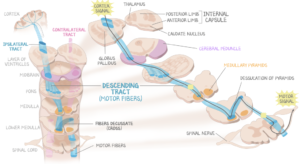
Trying not to deviate too far from the dimensions she was given, Schumacher very quickly presented several concepts of how motor tracts can be depicted.
During one of their frequent check-ins, Williams, Goodrich, and Schumacher considered the following questions:
-
Is the information wrong? No.
-
Is everything shown? No.
-
Will showing everything help learners understand? Yes.
With that, they decided the entire spinal cord would need to be depicted to get the story across.
Motor Tracts: Step 2: Showing the entire system within the set size ratio
After it was decided to depict the entire spinal cord while staying within the horizontal format, Schumacher came back with this.
Again, the team meets to review and ask another round of questions.
-
Does it show the entire spinal cord? Yes.
-
Is it an improvement from the last version? Yes.
-
Could it be better? Yes.
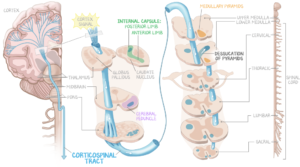
“The subject matter is complicated to begin with,” Goodrich says. “We felt that this abstraction—separating the spinal cord into two halves— of the structure was more distracting than it was helpful in regards to the information needing to be conveyed.”
-
Most importantly, can it be clearer? Yes.
The team decided that forcing a layout when it detracts from the learning objective doesn’t satisfy the goal. They would need to relax the size constraint so they could show the information in a more linear format. No more halved spinal cords.
Motor Tracts: Step 3: No more halved spinal cords
The team quickly and thoughtfully came up with full page dimensions, and Schumacher came back with this version.
At this point other illustration teams would have said “good enough.” The OnlineMedEd team saw an opportunity. Namely, that the information at the top regarding the topology of the fibers could be fleshed out with more detail.
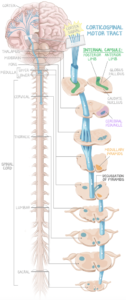
On this decision, Goodrich adds: “this is already a complicated concept to follow, so the more we can help the learners out, the better.
“If we’d stopped there, it would have been a missed opportunity, and it would have carried through to the other tract illustrations that would follow.”
The team decided to make the image full width as well—an entire page. This was a big deviation from the guidelines they’d initially set.
“We realized: we have more space now,” Goodrich explains. “Why not bend the rules a little more to see what gains we could make?”
Motor Tracts: Step 4: The whole shebang
After a few cracks at the new full-page layout, it immediately became clear that they were taking the right approach.
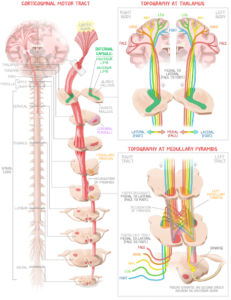
“This particular sequence of figures is an example of Mesa doing her best to adhere to our rules, us recognizing that the rules were holding her back, and quickly making changes on the fly so that she can execute more effectively,” Goodrich says. “No one here is settling for ‘close enough.’
“Regardless of execution, if you’re not focused on the right vision, there is work to be done. We strive for clarity and understanding. We don’t ever settle. And that’s what the learner feels when they’re in the content.”


